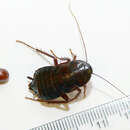Blatta orientalis, the oriental cockroach, is a shiny black or dark brown cockroach, ranging from 2.5-3.5 cms, found both indoors and outdoors. Although winged, these insects do not fly (males can fly up to a meter or two). The oriental cockroach is also known as the “water bug”, because of its preference for cool, damp environments. This species is thought to have originated in Africa, but is now found in every country world-wide. These cockroaches are omnivorous and will eat and drink anything available, preferring especially garbage or decaying matter and sugary and starchy foods. Human foods that are left out in homes can be contaminated by germs causing food poisoning, dysentery, diarrhea and other illness that these pests transport from garbage containers and other unsanitary environments. The oriental cockroach also produces an unpleasant odor, and are considered the dirties of home pests. Insecticides in bait, dust and spray forms can be used to eliminate this pest, however these roaches have developed resistance to many insecticides and are difficult to rid from dwellings. Sticky traps, keeping homes clean and putting food away also are important in helping to control infestations indoors. (
Rodrigues 2001;
Koehler, Oi and Branscome 2003;
McCanless 2000)

